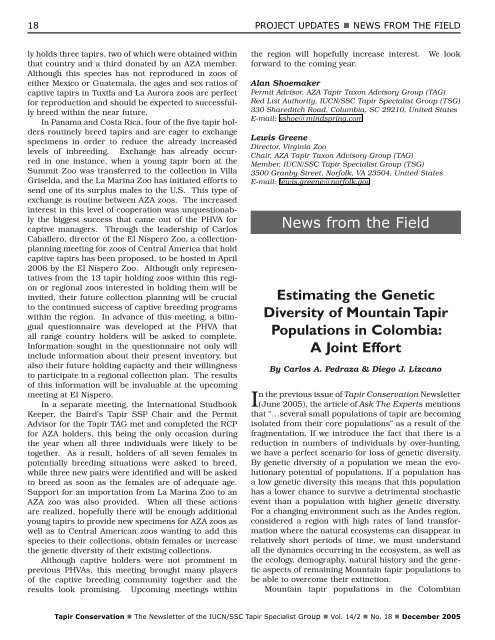Tapir Conservation - Tapir Specialist Group
Tapir Conservation - Tapir Specialist Group
Tapir Conservation - Tapir Specialist Group
You also want an ePaper? Increase the reach of your titles
YUMPU automatically turns print PDFs into web optimized ePapers that Google loves.
18<br />
ly holds three tapirs, two of which were obtained within<br />
that country and a third donated by an AZA member.<br />
Although this species has not reproduced in zoos of<br />
either Mexico or Guatemala, the ages and sex ratios of<br />
captive tapirs in Tuxtla and La Aurora zoos are perfect<br />
for reproduction and should be expected to successfully<br />
breed within the near future.<br />
In Panama and Costa Rica, four of the five tapir holders<br />
routinely breed tapirs and are eager to exchange<br />
specimens in order to reduce the already increased<br />
levels of inbreeding. Exchange has already occurred<br />
in one instance, when a young tapir born at the<br />
Summit Zoo was transferred to the collection in Villa<br />
Griselda, and the La Marina Zoo has initiated efforts to<br />
send one of its surplus males to the U.S. This type of<br />
exchange is routine between AZA zoos. The increased<br />
interest in this level of cooperation was unquestionably<br />
the biggest success that came out of the PHVA for<br />
captive managers. Through the leadership of Carlos<br />
Caballero, director of the El Níspero Zoo, a collectionplanning<br />
meeting for zoos of Central America that hold<br />
captive tapirs has been proposed, to be hosted in April<br />
2006 by the El Níspero Zoo. Although only representatives<br />
from the 13 tapir holding zoos within this region<br />
or regional zoos interested in holding them will be<br />
invited, their future collection planning will be crucial<br />
to the continued success of captive breeding programs<br />
within the region. In advance of this meeting, a bilingual<br />
questionnaire was developed at the PHVA that<br />
all range country holders will be asked to complete.<br />
Information sought in the questionnaire not only will<br />
include information about their present inventory, but<br />
also their future holding capacity and their willingness<br />
to participate in a regional collection plan. The results<br />
of this information will be invaluable at the upcoming<br />
meeting at El Níspero.<br />
In a separate meeting, the International Studbook<br />
Keeper, the Baird’s <strong>Tapir</strong> SSP Chair and the Permit<br />
Advisor for the <strong>Tapir</strong> TAG met and completed the RCP<br />
for AZA holders, this being the only occasion during<br />
the year when all three individuals were likely to be<br />
together. As a result, holders of all seven females in<br />
potentially breeding situations were asked to breed,<br />
while three new pairs were identified and will be asked<br />
to breed as soon as the females are of adequate age.<br />
Support for an importation from La Marina Zoo to an<br />
AZA zoo was also provided. When all these actions<br />
are realized, hopefully there will be enough additional<br />
young tapirs to provide new specimens for AZA zoos as<br />
well as to Central American zoos wanting to add this<br />
species to their collections, obtain females or increase<br />
the genetic diversity of their existing collections.<br />
Although captive holders were not prominent in<br />
previous PHVAs, this meeting brought many players<br />
of the captive breeding community together and the<br />
results look promising. Upcoming meetings within<br />
PROJECT UPDATES n NEWS FROM THE FIELD<br />
the region will hopefully increase interest. We look<br />
forward to the coming year.<br />
Alan Shoemaker<br />
Permit Advisor, AZA <strong>Tapir</strong> Taxon Advisory <strong>Group</strong> (TAG)<br />
Red List Authority, IUCN/SSC <strong>Tapir</strong> <strong>Specialist</strong> <strong>Group</strong> (TSG)<br />
330 Shareditch Road, Columbia, SC 29210, United States<br />
E-mail: sshoe@mindspring.com<br />
Lewis Greene<br />
Director, Virginia Zoo<br />
Chair, AZA <strong>Tapir</strong> Taxon Advisory <strong>Group</strong> (TAG)<br />
Member, IUCN/SSC <strong>Tapir</strong> <strong>Specialist</strong> <strong>Group</strong> (TSG)<br />
3500 Granby Street, Norfolk, VA 23504, United States<br />
E-mail: lewis.greene@norfolk.gov<br />
News from the Field<br />
Estimating the Genetic<br />
Diversity of Mountain <strong>Tapir</strong><br />
Populations in Colombia:<br />
A Joint Effort<br />
By Carlos A. Pedraza & Diego J. Lizcano<br />
In the previous issue of <strong>Tapir</strong> <strong>Conservation</strong> Newsletter<br />
(June 2005), the article of Ask The Experts mentions<br />
that “…several small populations of tapir are becoming<br />
isolated from their core populations” as a result of the<br />
fragmentation. If we introduce the fact that there is a<br />
reduction in numbers of individuals by over-hunting,<br />
we have a perfect scenario for loss of genetic diversity.<br />
By genetic diversity of a population we mean the evolutionary<br />
potential of populations. If a population has<br />
a low genetic diversity this means that this population<br />
has a lower chance to survive a detrimental stochastic<br />
event than a population with higher genetic diversity.<br />
For a changing environment such as the Andes region,<br />
considered a region with high rates of land transformation<br />
where the natural ecosystems can disappear in<br />
relatively short periods of time, we must understand<br />
all the dynamics occurring in the ecosystem, as well as<br />
the ecology, demography, natural history and the genetic<br />
aspects of remaining Mountain tapir populations to<br />
be able to overcome their extinction.<br />
Mountain tapir populations in the Colombian<br />
<strong>Tapir</strong> <strong>Conservation</strong> n The Newsletter of the IUCN/SSC <strong>Tapir</strong> <strong>Specialist</strong> <strong>Group</strong> n Vol. 14/2 n No. 18 n December 2005










